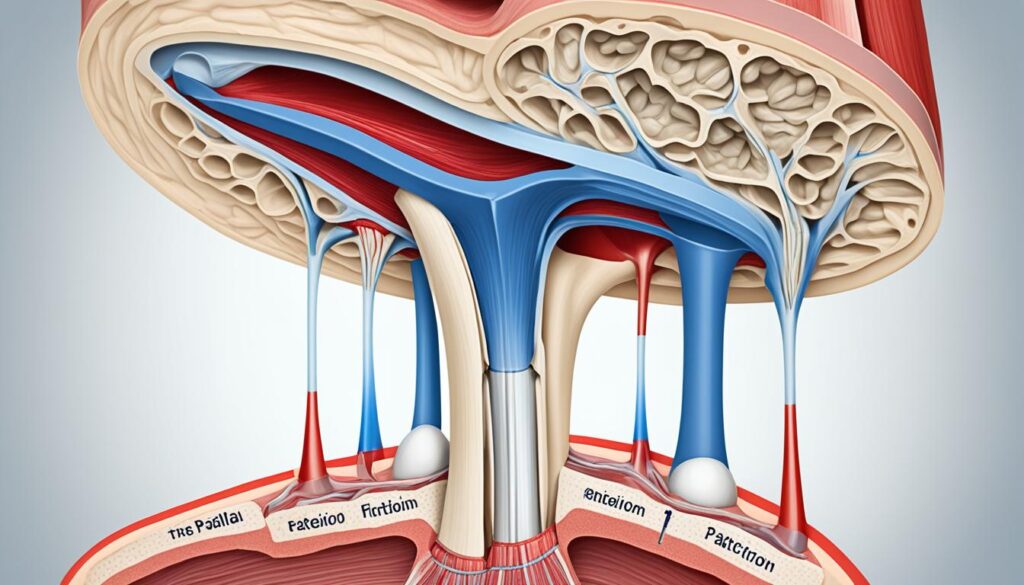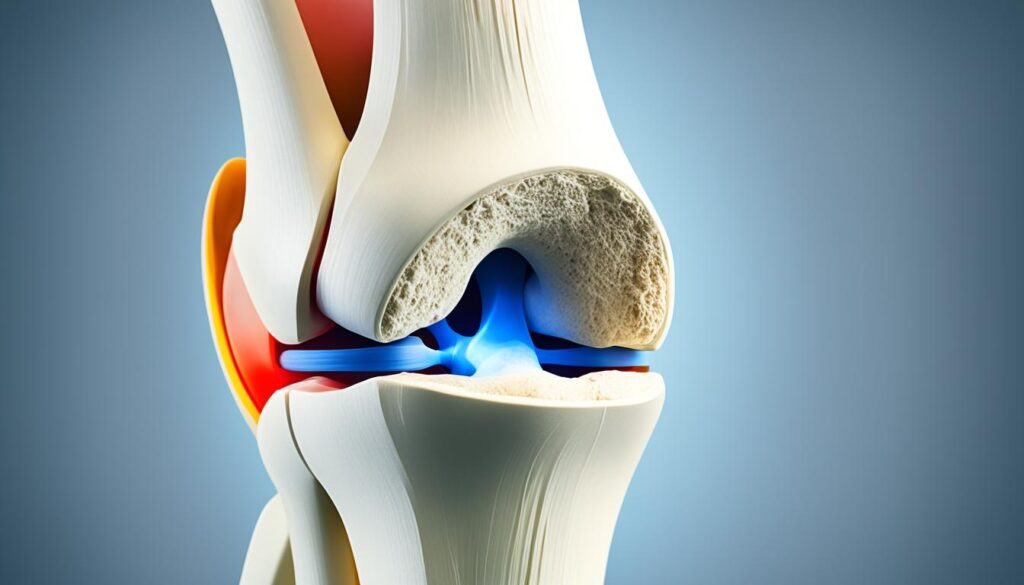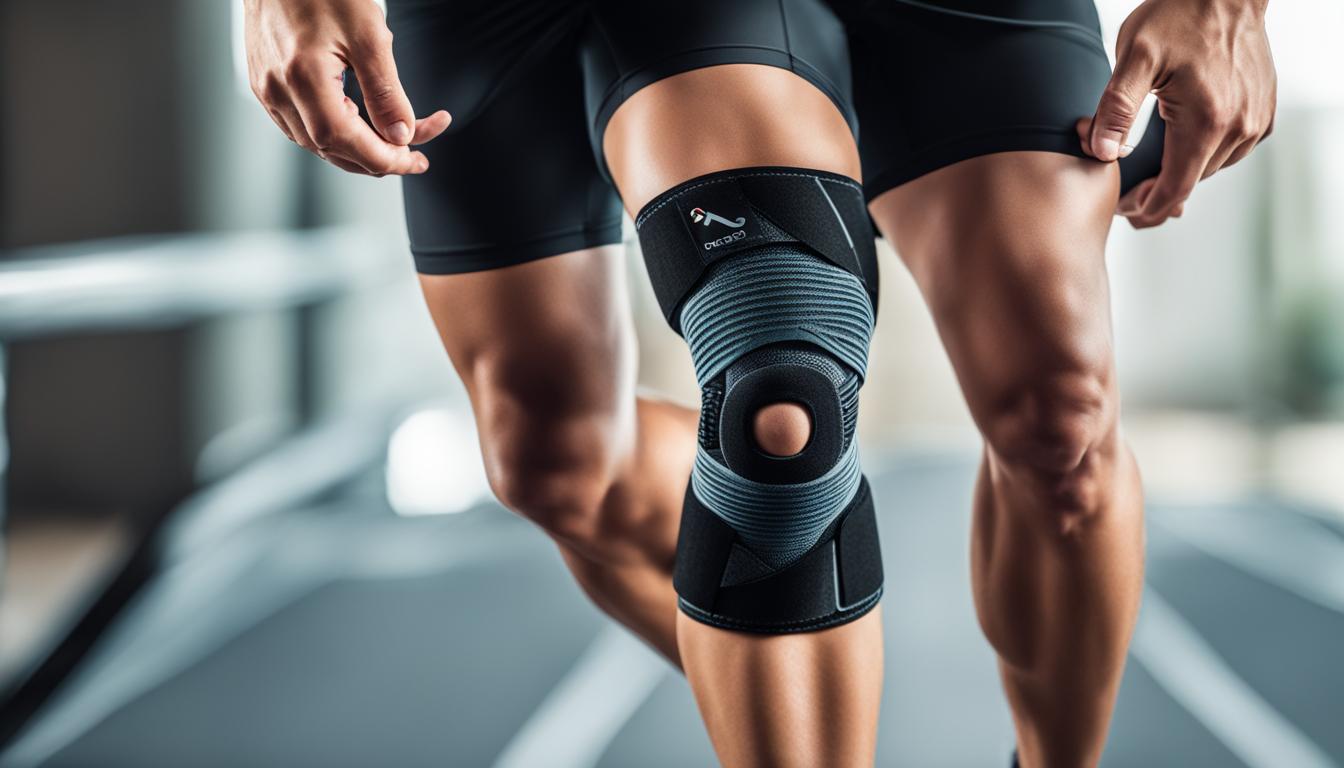Did you know that patella injuries account for approximately 5-6% of all musculoskeletal injuries? That’s a significant number considering the complexity and functionality of the knee joint. The patella, also known as the kneecap, plays a crucial role in knee stability and joint function.
Understanding when to use patella support, such as patella braces or straps, is essential for maximizing rehabilitation outcomes, improving joint function, and preventing further injuries. Join us as we explore the benefits, indications, limitations, and optimal usage of patella support in therapy. Whether you’re a healthcare professional or someone recovering from a patella injury, this comprehensive guide will equip you with the knowledge to make informed decisions about your treatment and rehabilitation.
Understanding Patella Function and Anatomy
The patella, commonly known as the kneecap, is a small bone located in front of the knee joint. It plays a crucial role in knee stability and joint function, contributing to the smooth movement of the lower limb. Let’s delve deeper into the function and anatomy of the patella.
The primary function of the patella is to act as a fulcrum, enhancing the leverage of the quadriceps muscles. This allows for efficient extension of the leg during activities like running, jumping, and squatting. By increasing the mechanical advantage of the quadriceps, the patella facilitates powerful movements and reduces the effort required by the muscles.

The patella is enclosed within the patellar tendon, which connects the quadriceps muscles to the tibia bone. This position provides protection for the patella and enables it to withstand the forces generated during weight-bearing activities.
An understanding of the patella’s anatomy is essential to grasp the significance of patella support in therapy. The patella is composed of a compact bone with a complex shape. It has a superior articular surface, which articulates with the femoral groove, and an inferior surface that attaches to the patellar tendon. The lateral and medial borders of the patella extend to form the attachments points for the vastus lateralis and vastus medialis muscles, respectively.
The patella, commonly known as the kneecap, is a small bone located in front of the knee joint. It acts as a fulcrum, improving the leverage of the quadriceps muscles and facilitating movements like running, jumping, and squatting.
Anatomy of the Patella
| Location | Composition | Structure |
|---|---|---|
| Located in front of the knee joint. | Composed of a compact bone. | Has a superior articular surface, an inferior surface attached to the patellar tendon, and lateral and medial borders for muscle attachment. |
Indications for Patella Support
When it comes to patella injuries, such as patellar tendinopathy, jumper’s knee, or patellar dislocation, patella support plays a vital role in the treatment and rehabilitation process. Additionally, individuals with conditions like patellofemoral pain syndrome, chondromalacia patella, or patellar instability can benefit from the use of patella support devices. These devices are designed to aid in improving patellar tracking, relieving pain, and facilitating recovery.
Therapeutic exercises and rehabilitation protocols often incorporate patella support as an essential component. By using patella support devices, healthcare professionals can help individuals with patella injuries regain range of motion, strengthen the surrounding muscles, and promote overall knee health. These devices serve as valuable tools in the journey towards complete rehabilitation and restoring normal joint function.
Benefits of Patella Support:
- Improved patellar tracking
- Pain relief
- Enhanced joint stability
- Facilitates recovery and rehabilitation
Relevant Exercises for Patella Support:
When incorporating patella support into therapy, specific exercises can further enhance its effectiveness. Some recommended exercises for patella support include:
- Isometric Quadriceps Contraction: Helps in strengthening the quadriceps muscles to support the patella.
- Patellar Tracking Exercises: Focuses on improving the alignment and tracking of the patella during movements.
- Patellar Tendon Stretches: Helps in reducing tension in the patellar tendon and promoting flexibility.
- Bridging: Strengthens the gluteal and hamstring muscles, providing overall support to the knee joint.
These exercises, when performed under the guidance of a healthcare professional, can contribute to the successful rehabilitation of patella injuries.
While patella support offers numerous benefits, it is important to acknowledge its limitations as well. Individuals using patella support devices should be aware that excessive reliance on these devices may hinder speed, agility, and athleticism. It is crucial to strike a balance between utilizing patella support devices for therapeutic purposes and gradually transitioning to activities without constant reliance on external support.
Achieving optimal use of patella support requires a comprehensive understanding of patella injuries, appropriate treatment strategies, relevant exercises, and the progressive rehabilitation process. By incorporating patella support into therapy protocols, we can maximize the potential for recovery, reduce pain, and improve overall functionality of the knee joint.

Types of Patella Support Devices
When it comes to providing effective support and protection to the patella, there are various types of patella support devices available on the market. These devices are specifically designed to address different needs and conditions, offering customized solutions for individuals seeking relief from patella-related issues. Let’s explore some of the most commonly used types of patella support devices:
- Patella Stabilizers: Patella stabilizers are designed to provide support and stability to the kneecap. They help in maintaining proper alignment and positioning of the patella, reducing the risk of displacement during physical activities.
- Patella Straps: Patella straps focus on reducing pain associated with conditions like patellar tendonitis. These straps offer targeted compression and support to the patellar tendon, minimizing discomfort and promoting healing.
- Knee Braces with Patella Support: Knee braces with patella support provide a comprehensive solution for individuals in need of enhanced protection and stability. These braces combine the benefits of patellar support with additional features to guard against patella dislocations and ligament injuries.
The choice of patella support device depends on the specific needs and conditions of the individual. It is important to consult with a healthcare professional or a qualified therapist to determine the most suitable option for optimal patella support.
Now that we have explored the different types of patella support devices, let’s move on to the next section to understand the benefits and limitations associated with using these devices in therapy.
Benefits and Limitations of Patella Support
Patella support devices offer numerous benefits in therapy, providing a range of advantages for individuals with knee issues. These devices can significantly improve patellar tracking, reducing pain and discomfort associated with conditions such as patellar tendinopathy or jumper’s knee. By providing targeted support, patella braces and straps promote enhanced joint stability and protect against further injuries during physical activities and rehabilitation.
One of the key benefits of patella support is its ability to improve proprioception – the sense of the body’s position in space. By providing external support to the knee, these devices enhance the body’s awareness of joint movement and positioning, allowing for better control and coordination during exercises or daily activities. This improved proprioception can bolster patient confidence and promote a faster and smoother recovery process.
Listed below are the key benefits of patella support:
- Improved patellar tracking
- Reduced pain and discomfort
- Enhanced joint stability
- Protection against further injuries
- Improved proprioception and control
While patella support devices offer significant benefits, it is essential to acknowledge their limitations. One potential limitation is the restriction of speed, agility, and overall athleticism. These devices can slightly impede movement and agility, which may affect performance in activities that require quick and dynamic motions.
Additionally, there is a risk of developing a false sense of security when relying solely on patella support devices. Patients may become overly dependent on the braces or straps, potentially neglecting essential muscle strengthening and coordination exercises. It is crucial to emphasize a comprehensive approach that combines patella support with appropriate rehabilitation exercises to achieve optimal outcomes.
Listed below are the limitations of patella support devices:
- Potential restrictions in speed, agility, and athleticism
- Risk of developing a false sense of security
- Possibility of brace-related contact injuries
Considering both the benefits and limitations of patella support devices is vital for healthcare professionals and patients alike. By understanding these aspects, informed decisions can be made regarding the optimal use of patella support in therapy, ensuring the best outcomes for individuals recovering from patella injuries and seeking improved knee health.
Conclusion
Patella support devices play a crucial role in therapy by enhancing rehabilitation, improving joint function, and preventing injuries. Understanding the patella’s function, indications for support, and the benefits and limitations of different devices is vital for optimal use. By incorporating patella support into therapy protocols, healthcare professionals can effectively assist individuals in recovering from patella injuries, managing pain, and improving overall knee health.
However, it is important to evaluate each case individually, considering factors such as the specific condition, treatment goals, and patient preferences. The decision to use patella support should be guided by a comprehensive assessment and a thorough understanding of the patient’s needs. This ensures that the chosen support device aligns with the individual’s requirements, providing the right level of stabilization and comfort.
When determining whether to use patella support, healthcare professionals must consider important aspects such as the type of injury, the stage of rehabilitation, and the patient’s level of physical activity. Patella support is particularly beneficial in cases of patella injuries, patellofemoral pain syndrome, chondromalacia patella, or patellar instability. Integrating patella support devices into therapy can optimize treatment outcomes, aiding individuals in regaining strength, improving mobility, and minimizing the risk of further knee complications.
FAQ
What is the patella and what is its function?
The patella, also known as the kneecap, is a small bone located in front of the knee joint. It acts as a fulcrum to improve the leverage of the quadriceps muscles and aids in the transmission of forces during movements like running, jumping, and squatting.
When is patella support indicated?
Patella support is indicated in various scenarios, including patella injuries such as patellar tendinopathy, jumper’s knee, or patellar dislocation. It can also be beneficial for individuals with patellofemoral pain syndrome, chondromalacia patella, or patellar instability.
What types of patella support devices are available?
There are various types of patella support devices available, including patella stabilizers, patella straps, and knee braces with patella support.
What are the benefits of patella support?
Patella support devices offer numerous benefits, including improved patellar tracking, reduced pain, enhanced joint stability, and protection against further injuries. They can also improve proprioception and confidence during physical activities.
What are the limitations of patella support?
Patella support devices have certain limitations, such as potential restrictions in speed, agility, and athleticism. There is also the risk of developing a false sense of security or experiencing brace-related contact injuries.
How should patella support be used in therapy?
The optimal use of patella support depends on understanding patella function, indications, and the benefits and limitations of different devices. Each case should be evaluated individually, considering factors like the specific condition, treatment goals, and patient preferences.

Leave a Reply